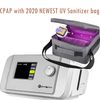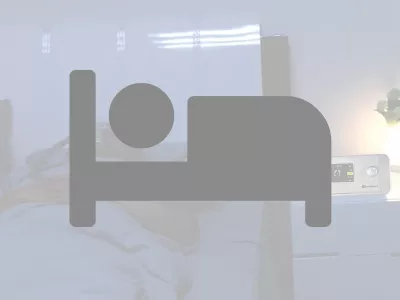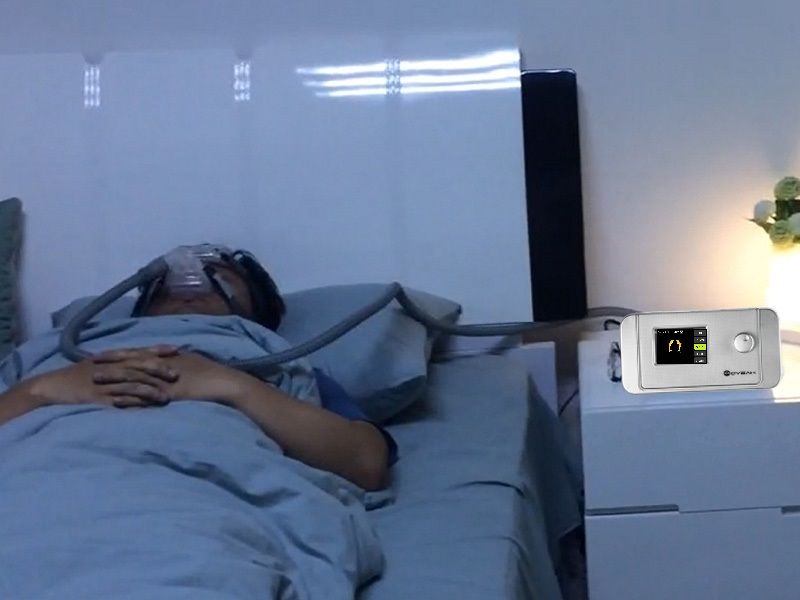CPAP For Sleep Apnea: What Is It?
- Healthy sleep. What is CPAP therapy? How to choose a CPAP device and not be mistaken?
- CPAP machines for the treatment of snoring and sleep apnea
- Types of sleep apnea
- The history of CPAP
- Indications and contraindications
- Key features of CPAP therapy
- Start of treatment
- Duration of treatment
- Choosing the right hardware
- What you need to pay attention to before buying a device
- CPAP price and accessories
CPAP, or SIPAP jargon (Continuous Positive Airway Pressure, constant additional air pressure or constant positive airway pressure, SDTP) what is it? This is a method of artificial lung ventilation, best known for the treatment of sleep apnea syndrome. It is also used to treat various types of respiratory failure through invasive and non-invasive ventilation.
The device for using this method is a special air pump connected to a special medical face mask that covers the nose or mouth and nose.
Healthy sleep. What is CPAP therapy? How to choose a CPAP device and not be mistaken?
Thanks to CPAP equipment, it is possible to cure apnea, which is caused by any problems with the respiratory tract, which include, for example, the proliferation of tissues of the palate.
CPAP machines for the treatment of snoring and sleep apnea
Sleep apnea is a fairly common and very dangerous disease. Its essence lies in the fact that a person stops breathing for more than 10 seconds during sleep. Sometimes apnea lasts about 20-30 seconds, but in advanced cases, this figure can increase up to 2-3 minutes.
Apnea often happens so often that it takes up to half of the time that the patient spends asleep. As a result, the quality of sleep is seriously impaired, and the patient feels sleepy and tired during the day. Apnea is also dangerous because it leads to an increase in blood pressure. Because of this, it can be considered the cause of various cardiovascular diseases, for example, heart attacks.
Types of sleep apnea
There are 2 main types of apnea - central and obstructive. The first type is usually associated with problems in the respiratory system. It is often found in young children (most often in premature babies).
Obstructive sleep apnea usually affects adults. It occurs due to narrowing of the airways, as well as too much relaxation of the pharyngeal muscles.
Thanks to CPAP equipment, it is possible to cure apnea, which is caused by any problems with the respiratory tract, which include, for example, the proliferation of tissues of the palate.
The CPAP equipment is rather small and does not take up much space. In fact, they are compact compressors. Their principle of operation is that they pump air under pressure into the patient's respiratory tract.
For this, special sealed hoses are used. Thanks to this, the airways do not close during sleep, and the likelihood of respiratory arrest is practically nonexistent.
Interestingly, CPAP machines are more than just compressors. They have a variety of functions, including monitoring the readings of the patient connected to the equipment. The obtained data is used by the doctor to adjust the settings of the CPAP machine and select the appropriate treatment strategy.
This technique can also be used to treat other conditions. This includes, for example, COPD, which is an obstruction of the lungs. The equipment allows to improve the patient's breathing. CPAP devices can be used not only during an exacerbation, but also at normal times if the course of the disease is very severe.
The duration of use of the CPAP machine depends on how severe the disease is. In some cases, it is required to operate throughout life. A little discomfort during sleep is no match for averting the threat of death. It should also be noted that the use of CPAP equipment is prescribed only after a special examination of the patient's condition.
CPAP Continuous positive airway pressure, on WikipediaThe history of CPAP
The CPAP method was invented back in the 80s. last century. The discovery was made in Australia. After research, it turned out that the CPAP method effectively helps to treat breathing disorders during sleep. Its essence lies in the fact that the required pressure is supplied to the respiratory tract. This helps prevent tissue from closing in the throat. A sealed circuit is responsible for the pressure. Air enters the respiratory tract through a hose and through a special mask.
It should be borne in mind that CPAP therapy does not have a cumulative effect. Therefore, the use of the CPAP machine must be continued for a long time. Otherwise, the patient will again face breathing problems.
Indications and contraindications
CPAP therapy is most often prescribed due to nighttime snoring. However, it should be borne in mind that the doctor pays attention to many factors.
Although therapy is considered safe enough, it should be borne in mind that it is not prescribed for:
- sinusitis;
- heart failure;
- hypotension;
- frequent bleeding;
- infectious diseases of the eyes;
- pneumotrax and so on.
If you have any of these diseases or health problems, CPAP therapy can be harmful. For this reason, doctors try not to prescribe it to such people. In this case, alternative methods of treatment are selected.
Key features of CPAP therapy
Features of the fight against snoring CPAP therapy has a positive effect due to the ability to customize the devices individually for each patient. Still, some uncomfortable sensations may appear. Such as:
- Irritation of the skin at the points of contact with the mask;
- Feeling of dryness in the respiratory system;
- Mild runny nose and nasal congestion;
- Unpleasant sensations during exhalation (appears from the continuous supply of oxygen);
- Malfunctions of the cardiac system during the first days of use (tachycardia, functional arrhythmia).
However, specialized medical equipment is improving all the time:
- To avoid irritation, you should take a mask of the correct size, made of hypoallergenic material. It can be purchased at specialized stores that sell medical equipment.
- The latest CPAP technology is equipped with a humidifier to prevent dry airways.
- Modern devices are equipped with sensors showing the percentage of oxygen pressure. They control its flow, so that its flow starts only when you inhale. Or if the patient has apnea. This allows you to minimize discomfort while using the equipment.
- The possibility of individual adjustment and adjustment during use eliminates the occurrence of heart problems.
Start of treatment
Before you start using medical equipment, you should definitely consult with the patient's doctor. The doctor - somnologist will study the problem from different angles and prescribe a detailed plan for the upcoming treatment with the use of equipment. Also, the doctor will contribute to the correct customization of the device within the walls of a medical institution.
For this, he will leave the patient in the hospital overnight. When the patient is asleep, the polysomnograph with the help of specially built-in sensors will monitor the main indicators of a person's respiration. He will study in detail the work of the entire respiratory system, the patient's pulse, his position in sleep, etc. With the help of the above information, the doctor will adjust the equipment and set the required pressure in such a way that the patient will not feel pain during its use.
The air compression method allows you to get rid of the main symptoms of OSAS:
- Snoring due to vibration of the soft palate blocking the entrance to the trachea and interfering with normal inhalation.
- Hypertension.
- Constant fatigue.
- Reducing distraction of attention.
- Decrease in concentration that occurs with sleep disturbance (insomnia).
Duration of treatment
After taking all the necessary tests and adjusting the equipment, the patient can continue treatment at home for several months. The more precise duration of the course of treatment is determined by the attending physician - it all depends on the complexity of the course of the patient's illness.
After a short break, treatment is resumed again. Equipment for CPAP therapy is a portable device that can be easily installed near a patient's bed or on a bedside table.
Unfortunately, this therapy cannot give an irreversible result or at least a long-term effect. Patients with severe forms of the disease are obliged to go through it all their lives. The cumulative effect of therapy is small and ends within a couple of days after the device is stopped. That is why it is necessary to tune the equipment very carefully.
Choosing the right hardware
There are three types of modern CPAP therapy equipment. Devices are:
- Standard. Oxygen is supplied to them continuously, regardless of the patient's breathing phase.
- BIPAP is a two-phase apparatus in which the air flow increases during inhalation and decreases during exhalation.
- Auto - CPAP, in which air enters only when the respiratory process stops, thereby helping the patient to breathe.
In addition to the special functions for adjusting the air supply (in BIPAPs and auto - CPAPs), there are also other additional features that make the use of the equipment as comfortable as possible. It:
- Smartflex - automatic pressure regulation at any phase of breathing.
- Heating. Required during autumn and winter use.
- Humidifier. Prevents dryness of the mucous membrane.
- Non-standard equipment sizes. Existing compact models allow you to move around without problems.
What you need to pay attention to before buying a device
Based on the above information, the answer to the question of how to stop snoring and dangerous sleep apnea is clear: consult a doctor and correctly set up the device for CPAP therapy. You should not take a test on one model of the device, and buying another is dangerous due to the appearance of unpleasant sensations.
This approach guarantees the patient the most comfortable use of the equipment during treatment. In addition, buying the device after individual adjustment and preliminary diagnostics of apnea will save you from additional expenses and you will be able to stop snoring.
And most importantly, it will help to exclude nighttime respiratory arrest, the occurrence of arrhythmias, strokes and heart attacks. There is no need to buy a device, focusing only on its advertising or reading the instructions yourself - this is wrong.
CPAP price and accessories
It is usually cheaper to get your own CPAP machine than to rent one from a sleeping clinic – in my case, I have been using a CPAP machine for two years, rented by a private clinic for $250 per trimester, while the whole machine price, brand new, was no more than $2000… in other words, I was better buying my own machine than renting from them.
After these two years, I moved to a mandibular advancement splint for $1000 for the first one about 8 years ago, and I haven’t moved back to CPAP ever since.
However, acquiring your own CPAP therapy machine online can be much cheaper than renting it out, and cost as less as $400 for the CPAP machine alone, to which you should add the price of tubing for less than $10 and a mask, my favorite one as being the most comfortable one is a CPAP nasal headgear that costs less than $100 – it’s always a good idea to have another one at hand, it case your main one breaks, as it happened to me after about a year of daily use.
| CPAP and accessories online | Image | Price | Buy |
|---|---|---|---|
| MOYEAH CPAP Snoring Machine and UV Sanitizer bag set Portable Breathing Device. With CPAP Nasal Mask, Strap, Tube, Filter, Travel Bag |  | $$$ | |
| 3B LG2A00 Luna II Auto CPAP & Heated Humidification | $$$ | ||
| CPAP nasal mask | $$ | ||
| CPAP tubing | $ |

